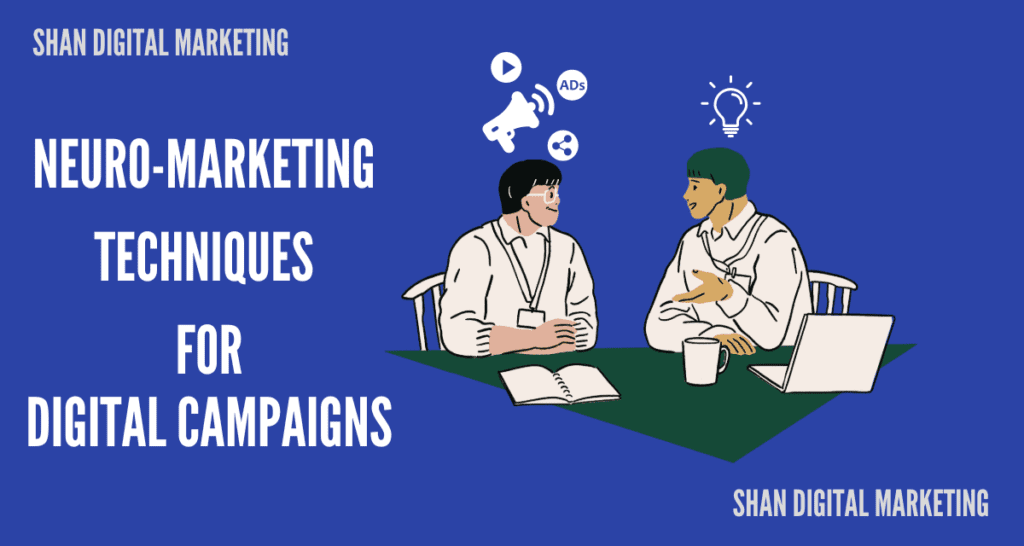Introduction
Brief Overview of Neuro-marketing
Neuro-marketing is an intriguing field that combines neuroscience with marketing. It explores how consumers’ brains respond to marketing stimuli and uses this knowledge to craft more effective campaigns. In today’s digital world, understanding neuro-marketing is crucial for creating campaigns that not only grab attention but also drive action.
Checkout our previous blog on Understanding Neuro-Marketing and Its Benefits.
Purpose of the Article
This article aims to provide informative insights into advanced neuro-marketing techniques for digital campaigns. Whether you’re a beginner or a seasoned professional, you’ll find valuable information to enhance your marketing strategies.
Understanding the Basics of Neuro-marketing
Neuro-marketing Explained
How Neuro-marketing Works
At its core, neuro-marketing involves studying the brain’s responses to various marketing stimuli. By understanding these responses, marketers can create content that better resonates with their audience.
Key Concepts: Emotions, Memory, and Decision-making
Emotions play a critical role in decision-making. When consumers develop a strong emotional connection to a brand, they are more likely to make a purchase. Memory is another crucial factor. Marketers aim to create memorable experiences that keep their brand at the top of consumers’ minds.
Scientific Foundation
Insights from Neuroscience
Neuroscience offers valuable insights into how the brain processes information. By leveraging these insights, marketers can design campaigns that align with how people naturally think and feel.
Psychological Principles Applied in Marketing
Understanding psychological principles such as the power of storytelling, social proof, and reciprocity can significantly enhance the effectiveness of digital campaigns.
Key Neuro-marketing Techniques for Digital Campaigns
Emotional Engagement
Techniques to Evoke Emotions in Digital Ads
Using emotional triggers in digital ads can significantly increase engagement. Emotional marketing can make your audience feel joy, surprise, or even fear, leading to a stronger connection with your brand.
Case Studies: Successful Emotional Campaigns
Brands like Coca-Cola and Apple have mastered the art of emotional marketing. Their campaigns often evoke strong emotions, creating lasting impressions on their audience.
Tools and Metrics to Measure Emotional Response
There are various tools available, such as facial coding and emotion AI, that help measure emotional responses to marketing content. These tools can provide insights into how your audience feels about your ads.
Visual Appeal and Brain Response
The Role of Colors, Fonts, and Layouts
Colors, fonts, and layouts can significantly impact how your audience perceives your brand. For example, warm colors like red and orange can evoke excitement, while cool colors like blue and green can create a sense of calm.
Designing Visually Engaging Content
Creating visually appealing content involves more than just choosing the right colors. It also requires using high-quality images, clear fonts, and a well-structured layout.
Eye-Tracking Studies and Their Implications
Eye-tracking studies provide insights into how people visually interact with your content. By understanding where users’ eyes focus, you can design more effective ads and websites.
Storytelling and Memory
Crafting Stories That Stick
Stories are powerful tools for creating memorable experiences. They enable your audience to connect with your brand on a deeper level.
The Science of Narrative Transportation
Narrative transportation refers to the process of becoming absorbed in a story. When consumers are transported into a story, they are more likely to remember the message and take action.
Examples of Effective Storytelling in Digital Campaigns
Brands like Nike and Airbnb use storytelling to create emotional connections with their audience. Their campaigns often feature compelling stories that resonate with consumers.
Personalization and Relevance
Leveraging Data for Personalized Marketing
Personalization involves using data to create tailored experiences for your audience. By understanding your customers’ preferences and behaviors, you can deliver more relevant content.
Techniques for Creating Relevant Content
There are several techniques for creating relevant content, such as using customer segmentation and dynamic content. These techniques help ensure that your marketing messages resonate with your audience.
Impact of Personalization on Consumer Brain
Personalization can significantly impact how consumers perceive your brand. When content is personalized, it feels more relevant and engaging, leading to higher levels of satisfaction and loyalty.
Social Proof and Influence
Using Testimonials, Reviews, and Influencers
Social proof involves leveraging testimonials, reviews, and influencers to build trust with your audience. These elements provide validation and encourage consumers to take action.
The Psychology of Social Proof
The concept of social proof is based on the idea that people tend to follow the actions of others. By showcasing positive experiences from other customers, you can influence potential buyers.
Strategies to Enhance Credibility and Trust
To enhance credibility, ensure that your testimonials and reviews are authentic. Additionally, partnering with trusted influencers can help boost your brand’s reputation.
Implementing Neuro-marketing in Digital Campaigns
Step-by-Step Guide
Setting Objectives Aligned with Neuro-marketing Goals
Start by defining clear objectives that align with your neuro-marketing goals. This might include increasing engagement, driving conversions, or building brand loyalty.
Identifying Target Audience and Their Neurological Triggers
Understanding your target audience is crucial. Identify their neurological triggers by analyzing data and conducting research. This will help you create content that resonates with them.
Creating Content that Resonates on a Neurological Level
Craft content that speaks to your audience’s emotions and cognitive processes. Use storytelling, personalization, and social proof to create a deeper connection.
Testing and Optimizing for Neuro-marketing Success
Regularly test and optimize your campaigns to ensure they are effective. Use tools like A/B testing and analytics to measure performance and make data-driven decisions.
Tools and Technologies
Neuro-marketing Software and Tools
There are several tools available to help you implement neuro-marketing techniques. These include emotion AI, facial coding, and eye-tracking software.
Analytics and Measurement for Neuro-marketing Campaigns
Use analytics tools to measure the effectiveness of your campaigns. Track metrics such as engagement, conversion rates, and emotional responses to gauge success.
Ethical Considerations
Ensuring Ethical Practices in Neuro-marketing
While neuro-marketing can be powerful, it’s essential to use it ethically. Respect your audience’s privacy and avoid manipulative tactics.
Balancing Persuasion with Consumer Respect
Strive to balance persuasion with respect for your consumers. Focus on creating value and building trust rather than solely driving sales.
Advanced Strategies for Professionals
Integrating AI with Neuro-marketing
AI Tools for Enhanced Neuro-marketing Insights
AI tools can provide deeper insights into your audience’s behavior and preferences. Use these tools to enhance your neuro-marketing strategies.
Predictive Analytics and Behavioral Targeting
Predictive analytics can help you anticipate your audience’s needs and tailor your marketing efforts accordingly. Behavioral targeting allows you to deliver more relevant content.
Future Trends in Neuro-marketing
Emerging Technologies and Their Impact
Stay ahead by monitoring emerging technologies.Innovations in AI, VR, and AR are shaping the future of neuro-marketing.
Preparing for the Future of Neuro-marketing
As technology evolves, so will neuro-marketing. Stay informed and adaptable to ensure your strategies remain effective.
Conclusion
Recap of Key Points
In this article, we explored various neuro-marketing techniques that can enhance your digital campaigns. From emotional engagement and visual appeal to storytelling and personalization, each technique plays a crucial role in connecting with your audience on a deeper level. We’ve also discussed the importance of leveraging social proof and advanced technologies like AI to stay ahead in the competitive digital landscape.
Final Thoughts
The field of neuro-marketing offers powerful tools to understand and influence consumer behavior. By continuously learning and adapting to new insights, marketers can create more effective and ethical campaigns. It’s essential to balance persuasion with respect for the consumer, ensuring that your marketing efforts build trust and provide genuine value.
Author

John, our Website Manager, is the architect behind seamless online experiences. With a keen eye for detail, he ensures your digital space is not only visually stunning but also intuitively functional. From design optimization to user-centric features, John's expertise lies in crafting websites that captivate and convert. Trust him to elevate your online presence to new heights.
View all posts







